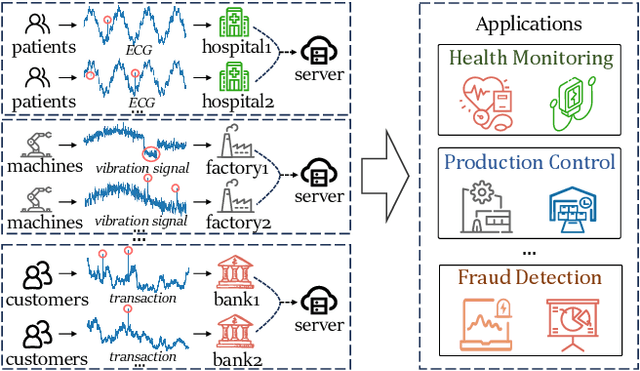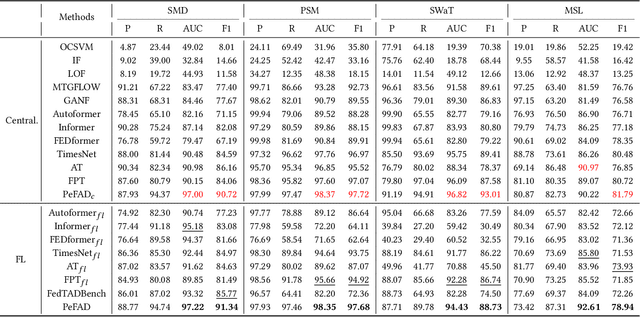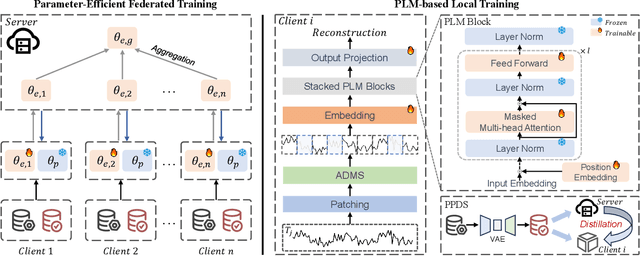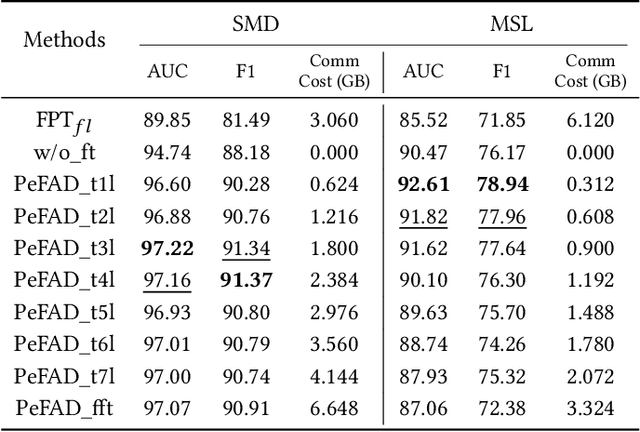Senzhang Wang
Corresponding author
STAMImputer: Spatio-Temporal Attention MoE for Traffic Data Imputation
Jun 11, 2025Abstract:Traffic data imputation is fundamentally important to support various applications in intelligent transportation systems such as traffic flow prediction. However, existing time-to-space sequential methods often fail to effectively extract features in block-wise missing data scenarios. Meanwhile, the static graph structure for spatial feature propagation significantly constrains the models flexibility in handling the distribution shift issue for the nonstationary traffic data. To address these issues, this paper proposes a SpatioTemporal Attention Mixture of experts network named STAMImputer for traffic data imputation. Specifically, we introduce a Mixture of Experts (MoE) framework to capture latent spatio-temporal features and their influence weights, effectively imputing block missing. A novel Low-rank guided Sampling Graph ATtention (LrSGAT) mechanism is designed to dynamically balance the local and global correlations across road networks. The sampled attention vectors are utilized to generate dynamic graphs that capture real-time spatial correlations. Extensive experiments are conducted on four traffic datasets for evaluation. The result shows STAMImputer achieves significantly performance improvement compared with existing SOTA approaches. Our codes are available at https://github.com/RingBDStack/STAMImupter.
FilterLLM: Text-To-Distribution LLM for Billion-Scale Cold-Start Recommendation
Feb 24, 2025Abstract:Large Language Model (LLM)-based cold-start recommendation systems continue to face significant computational challenges in billion-scale scenarios, as they follow a "Text-to-Judgment" paradigm. This approach processes user-item content pairs as input and evaluates each pair iteratively. To maintain efficiency, existing methods rely on pre-filtering a small candidate pool of user-item pairs. However, this severely limits the inferential capabilities of LLMs by reducing their scope to only a few hundred pre-filtered candidates. To overcome this limitation, we propose a novel "Text-to-Distribution" paradigm, which predicts an item's interaction probability distribution for the entire user set in a single inference. Specifically, we present FilterLLM, a framework that extends the next-word prediction capabilities of LLMs to billion-scale filtering tasks. FilterLLM first introduces a tailored distribution prediction and cold-start framework. Next, FilterLLM incorporates an efficient user-vocabulary structure to train and store the embeddings of billion-scale users. Finally, we detail the training objectives for both distribution prediction and user-vocabulary construction. The proposed framework has been deployed on the Alibaba platform, where it has been serving cold-start recommendations for two months, processing over one billion cold items. Extensive experiments demonstrate that FilterLLM significantly outperforms state-of-the-art methods in cold-start recommendation tasks, achieving over 30 times higher efficiency. Furthermore, an online A/B test validates its effectiveness in billion-scale recommendation systems.
FairTP: A Prolonged Fairness Framework for Traffic Prediction
Dec 18, 2024Abstract:Traffic prediction plays a crucial role in intelligent transportation systems. Existing approaches primarily focus on improving overall accuracy, often neglecting a critical issue: whether predictive models lead to biased decisions by transportation authorities. In practice, the uneven deployment of traffic sensors across urban areas results in imbalanced data, causing prediction models to perform poorly in certain regions and leading to unfair decision-making. This imbalance ultimately harms the equity and quality of life for residents. Moreover, current fairness-aware machine learning models only ensure fairness at specific time points, failing to maintain fairness over extended periods. As traffic conditions change, such static fairness approaches become ineffective. To address this gap, we propose FairTP, a framework for prolonged fair traffic prediction. We introduce two new fairness definitions tailored for dynamic traffic scenarios. Fairness in traffic prediction is not static; it varies over time and across regions. Each sensor or urban area can alternate between two states: "sacrifice" (low prediction accuracy) and "benefit" (high prediction accuracy). Prolonged fairness is achieved when the overall states of sensors remain similar over a given period. We define two types of fairness: region-based static fairness and sensor-based dynamic fairness. To implement this, FairTP incorporates a state identification module to classify sensors' states as either "sacrifice" or "benefit," enabling prolonged fairness-aware predictions. Additionally, we introduce a state-guided balanced sampling strategy to further enhance fairness, addressing performance disparities among regions with uneven sensor distributions. Extensive experiments on two real-world datasets demonstrate that FairTP significantly improves prediction fairness while minimizing accuracy degradation.
C2F-TP: A Coarse-to-Fine Denoising Framework for Uncertainty-Aware Trajectory Prediction
Dec 17, 2024Abstract:Accurately predicting the trajectory of vehicles is critically important for ensuring safety and reliability in autonomous driving. Although considerable research efforts have been made recently, the inherent trajectory uncertainty caused by various factors including the dynamic driving intends and the diverse driving scenarios still poses significant challenges to accurate trajectory prediction. To address this issue, we propose C2F-TP, a coarse-to-fine denoising framework for uncertainty-aware vehicle trajectory prediction. C2F-TP features an innovative two-stage coarse-to-fine prediction process. Specifically, in the spatial-temporal interaction stage, we propose a spatial-temporal interaction module to capture the inter-vehicle interactions and learn a multimodal trajectory distribution, from which a certain number of noisy trajectories are sampled. Next, in the trajectory refinement stage, we design a conditional denoising model to reduce the uncertainty of the sampled trajectories through a step-wise denoising operation. Extensive experiments are conducted on two real datasets NGSIM and highD that are widely adopted in trajectory prediction. The result demonstrates the effectiveness of our proposal.
FuseAnyPart: Diffusion-Driven Facial Parts Swapping via Multiple Reference Images
Oct 30, 2024Abstract:Facial parts swapping aims to selectively transfer regions of interest from the source image onto the target image while maintaining the rest of the target image unchanged. Most studies on face swapping designed specifically for full-face swapping, are either unable or significantly limited when it comes to swapping individual facial parts, which hinders fine-grained and customized character designs. However, designing such an approach specifically for facial parts swapping is challenged by a reasonable multiple reference feature fusion, which needs to be both efficient and effective. To overcome this challenge, FuseAnyPart is proposed to facilitate the seamless "fuse-any-part" customization of the face. In FuseAnyPart, facial parts from different people are assembled into a complete face in latent space within the Mask-based Fusion Module. Subsequently, the consolidated feature is dispatched to the Addition-based Injection Module for fusion within the UNet of the diffusion model to create novel characters. Extensive experiments qualitatively and quantitatively validate the superiority and robustness of FuseAnyPart. Source codes are available at https://github.com/Thomas-wyh/FuseAnyPart.
When Graph meets Multimodal: Benchmarking on Multimodal Attributed Graphs Learning
Oct 11, 2024



Abstract:Multimodal attributed graphs (MAGs) are prevalent in various real-world scenarios and generally contain two kinds of knowledge: (a) Attribute knowledge is mainly supported by the attributes of different modalities contained in nodes (entities) themselves, such as texts and images. (b) Topology knowledge, on the other hand, is provided by the complex interactions posed between nodes. The cornerstone of MAG representation learning lies in the seamless integration of multimodal attributes and topology. Recent advancements in Pre-trained Language/Vision models (PLMs/PVMs) and Graph neural networks (GNNs) have facilitated effective learning on MAGs, garnering increased research interest. However, the absence of meaningful benchmark datasets and standardized evaluation procedures for MAG representation learning has impeded progress in this field. In this paper, we propose Multimodal Attribute Graph Benchmark (MAGB)}, a comprehensive and diverse collection of challenging benchmark datasets for MAGs. The MAGB datasets are notably large in scale and encompass a wide range of domains, spanning from e-commerce networks to social networks. In addition to the brand-new datasets, we conduct extensive benchmark experiments over MAGB with various learning paradigms, ranging from GNN-based and PLM-based methods, to explore the necessity and feasibility of integrating multimodal attributes and graph topology. In a nutshell, we provide an overview of the MAG datasets, standardized evaluation procedures, and present baseline experiments. The entire MAGB project is publicly accessible at https://github.com/sktsherlock/ATG.
Unleash LLMs Potential for Recommendation by Coordinating Twin-Tower Dynamic Semantic Token Generator
Sep 14, 2024Abstract:Owing to the unprecedented capability in semantic understanding and logical reasoning, the pre-trained large language models (LLMs) have shown fantastic potential in developing the next-generation recommender systems (RSs). However, the static index paradigm adopted by current methods greatly restricts the utilization of LLMs capacity for recommendation, leading to not only the insufficient alignment between semantic and collaborative knowledge, but also the neglect of high-order user-item interaction patterns. In this paper, we propose Twin-Tower Dynamic Semantic Recommender (TTDS), the first generative RS which adopts dynamic semantic index paradigm, targeting at resolving the above problems simultaneously. To be more specific, we for the first time contrive a dynamic knowledge fusion framework which integrates a twin-tower semantic token generator into the LLM-based recommender, hierarchically allocating meaningful semantic index for items and users, and accordingly predicting the semantic index of target item. Furthermore, a dual-modality variational auto-encoder is proposed to facilitate multi-grained alignment between semantic and collaborative knowledge. Eventually, a series of novel tuning tasks specially customized for capturing high-order user-item interaction patterns are proposed to take advantages of user historical behavior. Extensive experiments across three public datasets demonstrate the superiority of the proposed methodology in developing LLM-based generative RSs. The proposed TTDS recommender achieves an average improvement of 19.41% in Hit-Rate and 20.84% in NDCG metric, compared with the leading baseline methods.
GPT4Rec: Graph Prompt Tuning for Streaming Recommendation
Jun 12, 2024



Abstract:In the realm of personalized recommender systems, the challenge of adapting to evolving user preferences and the continuous influx of new users and items is paramount. Conventional models, typically reliant on a static training-test approach, struggle to keep pace with these dynamic demands. Streaming recommendation, particularly through continual graph learning, has emerged as a novel solution. However, existing methods in this area either rely on historical data replay, which is increasingly impractical due to stringent data privacy regulations; or are inability to effectively address the over-stability issue; or depend on model-isolation and expansion strategies. To tackle these difficulties, we present GPT4Rec, a Graph Prompt Tuning method for streaming Recommendation. Given the evolving user-item interaction graph, GPT4Rec first disentangles the graph patterns into multiple views. After isolating specific interaction patterns and relationships in different views, GPT4Rec utilizes lightweight graph prompts to efficiently guide the model across varying interaction patterns within the user-item graph. Firstly, node-level prompts are employed to instruct the model to adapt to changes in the attributes or properties of individual nodes within the graph. Secondly, structure-level prompts guide the model in adapting to broader patterns of connectivity and relationships within the graph. Finally, view-level prompts are innovatively designed to facilitate the aggregation of information from multiple disentangled views. These prompt designs allow GPT4Rec to synthesize a comprehensive understanding of the graph, ensuring that all vital aspects of the user-item interactions are considered and effectively integrated. Experiments on four diverse real-world datasets demonstrate the effectiveness and efficiency of our proposal.
PeFAD: A Parameter-Efficient Federated Framework for Time Series Anomaly Detection
Jun 04, 2024



Abstract:With the proliferation of mobile sensing techniques, huge amounts of time series data are generated and accumulated in various domains, fueling plenty of real-world applications. In this setting, time series anomaly detection is practically important. It endeavors to identify deviant samples from the normal sample distribution in time series. Existing approaches generally assume that all the time series is available at a central location. However, we are witnessing the decentralized collection of time series due to the deployment of various edge devices. To bridge the gap between the decentralized time series data and the centralized anomaly detection algorithms, we propose a Parameter-efficient Federated Anomaly Detection framework named PeFAD with the increasing privacy concerns. PeFAD for the first time employs the pre-trained language model (PLM) as the body of the client's local model, which can benefit from its cross-modality knowledge transfer capability. To reduce the communication overhead and local model adaptation cost, we propose a parameter-efficient federated training module such that clients only need to fine-tune small-scale parameters and transmit them to the server for update. PeFAD utilizes a novel anomaly-driven mask selection strategy to mitigate the impact of neglected anomalies during training. A knowledge distillation operation on a synthetic privacy-preserving dataset that is shared by all the clients is also proposed to address the data heterogeneity issue across clients. We conduct extensive evaluations on four real datasets, where PeFAD outperforms existing state-of-the-art baselines by up to 28.74\%.
Deep Multi-View Channel-Wise Spatio-Temporal Network for Traffic Flow Prediction
Apr 23, 2024



Abstract:Accurately forecasting traffic flows is critically important to many real applications including public safety and intelligent transportation systems. The challenges of this problem include both the dynamic mobility patterns of the people and the complex spatial-temporal correlations of the urban traffic data. Meanwhile, most existing models ignore the diverse impacts of the various traffic observations (e.g. vehicle speed and road occupancy) on the traffic flow prediction, and different traffic observations can be considered as different channels of input features. We argue that the analysis in multiple-channel traffic observations might help to better address this problem. In this paper, we study the novel problem of multi-channel traffic flow prediction, and propose a deep \underline{M}ulti-\underline{V}iew \underline{C}hannel-wise \underline{S}patio-\underline{T}emporal \underline{Net}work (MVC-STNet) model to effectively address it. Specifically, we first construct the localized and globalized spatial graph where the multi-view fusion module is used to effectively extract the local and global spatial dependencies. Then LSTM is used to learn the temporal correlations. To effectively model the different impacts of various traffic observations on traffic flow prediction, a channel-wise graph convolutional network is also designed. Extensive experiments are conducted over the PEMS04 and PEMS08 datasets. The results demonstrate that the proposed MVC-STNet outperforms state-of-the-art methods by a large margin.
 Add to Chrome
Add to Chrome Add to Firefox
Add to Firefox Add to Edge
Add to Edge